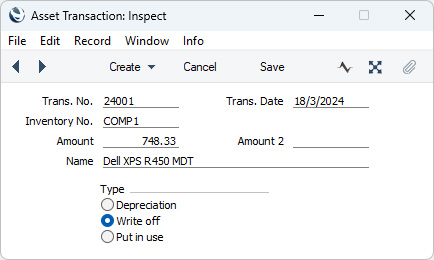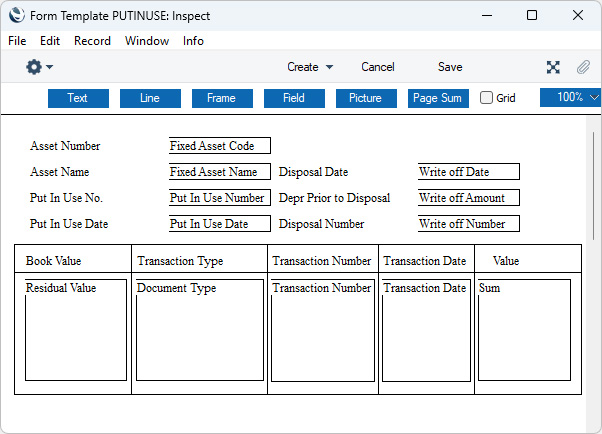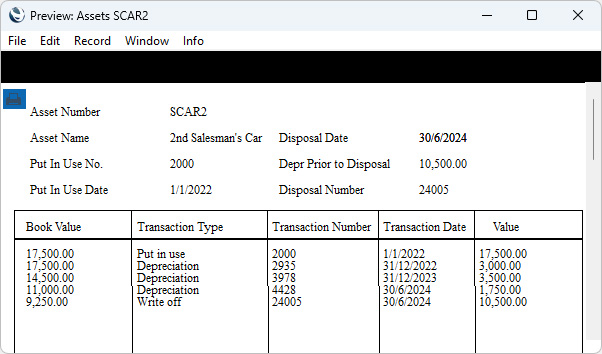The Asset Transaction Register
The purpose of the Asset Transaction register is to help maintain a history of your Assets. New Asset Transaction records will be created automatically after any of the following actions:
- Creating a Put In Use Transaction for an Asset
- Writing off or selling an Asset through a Disposal record (Asset Transactions will only be created from Disposals if you have selected the Asset Disposals option in the Sub Systems setting in the Nominal Ledger. Selecting this option will also cause Nominal Ledger Transactions to be created from Disposals).
- Depreciating an Asset using the 'Create Depreciation Transactions' Maintenance function. The 'Create Depreciation Simulations' Maintenance function will not cause Asset Transaction records to be created: if you will use this function to depreciate your Assets, you can enter Asset Transactions yourself to maintain a depreciation history for your Assets.
The task of maintaining Asset histories is shared between two registers. As listed above, a history of Nominal Ledger postings is maintained in the Asset Transaction register, while a history of ownership (e.g. of the Departments in which Assets are located and of the Persons responsible for them) is maintained in the
Asset Status register.
To open the Asset Transaction register, first ensure you are in the Assets module. Then, if you are using Windows or macOS, click the [Registers] button in the Navigation Centre and double-click 'Asset Transactions' in the resulting list. If you are using iOS or Android, tap the [Registers] button in the Navigation Centre and then tap 'Asset Transactions' in the 'Registers' list. The 'Asset Transactions: Browse' window will be opened. Double-click (Windows/macOS) or tap (iOS/Android) a record in the list to see its details.

The Transaction Number field contains the serial number of the originating Transaction (i.e. depreciation Transaction,
Put in Use Transaction or
Disposal), while the other fields and options are self-explanatory.
The Asset Transaction register is only a historical record and has no effect on the future calculation of depreciation. As described here, there is no reference to any previously saved figures when depreciation is calculated for a new month or year. For example, when you calculate depreciation at the end of 2025 for an Asset purchased at the beginning of 2024, depreciation will effectively be calculated for both 2024 and 2025 to arrive at the figure for 2025. Each time you calculate depreciation using the 'Create Depreciation Transactions' Maintenance function, a depreciation figure will be stored in the Asset Transaction register, but in future the depreciation calculation will not refer back to these figures. The purposes for storing depreciation figures in the Asset Transaction register are:
- To allow you to use the Check for existing Transactions option when running the 'Create Depreciation Transactions' Maintenance function. This option can help prevent an Asset being depreciated twice in the same period.
- To enable them to be printed (together with Nominal Ledger Transaction Numbers and Dates) in the Asset Put In Use form as part of an Asset's depreciation history.
If you want to print an Asset's depreciation history in the
Asset Put In Use form, include the fields described below when designing the Form Template. The Form Type of the Form Template should be "Asset put in use". A full list of the fields that you can include in the Form Template can be found
here while Form Template design in general is described
here.
The following fields are printed once per Asset in the Put In Use form:
- Fixed Asset Code
- The Inventory Number of the Asset.
- Fixed Asset Name
- The Name of the Asset.
- Put In Use Number
- The Transaction Number of the Put In Use Transaction.
- Put In Use Date
- The Date of the Put In Use Transaction.
- Write off Date
- The Date of the Disposal Transaction.
- Write off Amount
- The amount the Asset was depreciated by before it was written off or sold (i.e. the figure in the Depr. field in the Disposal record).
The following fields are printed as many times as necessary (i.e. as many times as there are Asset Transaction records for the Asset), so you can arrange them in a table (be sure to specify a Vertical Spacing in each one):
- Transaction Number
- The serial number of the originating Transaction (i.e. depreciation Transaction, Put in Use Transaction or Disposal).
- Transaction Date (transdate)
- The date of the Asset Transaction.
- Document Type
- The type of the Asset Transaction (Put In Use, depreciation or Disposal).
- Residual Value
- The book value of the Asset prior to the Asset Transaction.
- Sum
- The value of the Asset Transaction (usually the Purchase Value in the case of a (Put In Use Transaction, monthly or annual depreciation, or accumulated depreciation on disposal).
An example Form Template is illustrated below:

This is the printed output:

---
Go back to:
